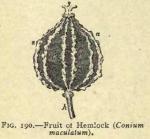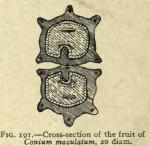The full-grown, but unripe fruit of Con'ium macula'tum Linné, carefully dried and preserved, should yield by assay, not less than 0.5 per cent. of coniine. It should not be kept longer than two years.
DESCRIPTION OF DRUG.—Gathered when full grown but yet green, the yield of alkaloid being greatest at this time. Small, roundish-ovate, laterally compressed, grayish-green. The mericarps, which are often separated, have five jagged ribs but no oil-tubes; the flat side or commissure is deeply furrowed, giving to a transverse cut surface a reniform outline. Almost odorless; taste disagreeable and somewhat acrid; when triturated with a solution of KOH, conium emits the peculiar, mouse-like odor characteristic of the volatile alkaloid, coniine, which is liberated thereby. The total alkaloids in the fruit may reach as high as 3.5 per cent., rapidly diminishing as it ripens.
Powder.—Pale yellowish-brown. Characteristic elements: Parenchyma of endosperm, rather thick-walled with oil globules and aleurone (4 to 7 µ in diam.); aggregate calcium oxalate (1 to 2 µ in diam.); other parenchyma with starch and chloroplastids; sclerenchyma, from fruit and stalk with bast fibers, long and thin-walled, with numerous pores; collenchymatous cells from mericarp, yellowish, nearly isodiametrical, irregularly thickened.
CONSTITUENTS.—The liquid alkaloid, coniine, C8H17N (the active constituent), methyl coniine, C8H16(CH3)N (also liquid), conhydrine, and its isomer, pseudoconiine. Coniine is a yellowish, oily, volatile liquid (sp. gr. 0.88), very acrid, and of a strong, mouse-like odor; it is strongly basic, and is combined in the fruit with conhydric acid, from which it may instantly be freed and its odor developed in the fruit by rubbing with potassa, as noted above; its action is that of a paralyzant to the motor nervous system. Methyl coniine resembles it inaction. Conhydrine is in iridescent scales, melting at 120.6 °C.
Preparation of Coniine.—Liberated from drug by distilling it with alkali. Methyl coniine and conhydrine is likely to come over with it.
Separation of Conhydrine from Coniine.—Reduce the temperature of the oily liquid containing the two by a freezing mixture. Recrystallize from ether. Occurs in iridescent scales, less poisonous than coniine.
ACTION AND USES.—Conium is narcotic and sedative; its principal action is as a paralyzant to the motor nerves. Dose: 3 to 5 gr. (0.2 to 0.3 Gm.). The alkaloid coniine is an active poison, the dose being from ¼ to ½ drops (0.0164 to 0.0324 mil); dose of the hydrochlorate is probably about ⅙ gr. (0.01 Gm.).
384. CONII FOLIA.—HEMLOCK LEAVES. Grayish-green, thin, smooth, from 100 to 300 mm. (4 to 12 in.) long, twice or thrice decompound, with oblong-lanceolate, acute, sharply serrate divisions; petiolate, the petiole hollow; odor mouse-like; taste disagreeable. They contain coniine in very small quantity, and are less active than the fruit, but used for the same purposes as an anodyne and antispasmodic for controlling maniacal excitement and spasmodic affections, such as whooping-cough, etc. Dose: about 5 gr. (0.3 Gm.).



